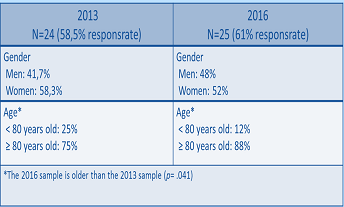
Liv Berit Fagerli
Østfold University College, Norway
Title: The impact of person-centered care on older people’s perceptions of care quality in nursing homes: An intervention study
Biography
Biography: Liv Berit Fagerli
Abstract
Statement of the Problem: The quality of care offered to older people in nursing homes varies. Nursing home administrators often claim that they provide person-centered care, but research indicates that institutional goals take precedence. Personcentered care may influence the older people’s quality of life. The purpose of this study was to explore the impact of personcentered
care on older people’s perceptions of care quality.
Methodology & Theoretical Orientation: In our study, person-centered care was operationalized into one intervention: oneto-one contact (resident – carer). The intervention was systematically conducted for 12 months in one nursing home (41residents). One of the carers should spend 30 minutes twice a week alone with one resident. This form of companionship comprised activities such as talking, watching TV and going for a walk. Face-to-face interviews using the Quality from Patient’s Perspective (QPP) questionnaire were conducted both prior to intervention and immediately after the 12-month period. The
questionnaire comprises of four dimensions: caregivers’ medical-technical competence and identity-oriented approach, and care organisation’s socio-cultural approach and physical-technical conditions. Descriptive and comparative statistics were used to test for differences between care quality perceptions before and after intervention (p<.05).
Results: The older people rated all four quality dimensions significantly higher after the 12-month period. At the item level significantly higher scores were given to ‘The healthcare personnel showed commitment’, ‘The healthcare personnel were respectful towards me’,‘I received the best possible medical care’ and ‘There was a pleasant atmosphere on the ward’.

Sample characteristics
Conclusion & Significance: Older people’s perceptions of care quality increase when person-centered care is operationalized and takes precedence over ward routines. The results indicate that it is possible to design a care system where the older people are at the center of the health care offered.
Recent Publications:
- Askari M, Wierenga PC, Eslami S, Medlock S, Rooij SE, Abu-Hanna A (2011) “Assessing quality of care of elderly patients using the ACOVE quality indicator set: a systematic review”, PLoS ONE, Vol. 6 No. 12, e28631.
- Backhaus R, Verbeek H, van Rossum E, Capezuti E, Hamers JPH (2014) “Nurse staffing impact on quality of care in nursing homes: a systematic review of longitudinal studies”, Journal of the American Medical Directors Association, Vol. 15 No. 6, pp. 383-93.
- Grøndahl VA, Fagerli LB Nursing home care quality: a cluster analysis. International Journal of Health Care Quality Assurance. (in press)
- Hasson H, Arnetz JE (2010) “A comparative study of nursing staff, care recipients’ and their relatives’ perceptions of quality of older people care”, International Journal of Older People Nursing, Vol. 5 No. 1, pp. 5-15.
- Hughes K, Moore S (2012) “Quality of life versus quality of care: elderly people and their experience of care in South Australian residential facilities”, Practice: Social Work in Action, Vol. 24 No. 5, pp. 275-285.


